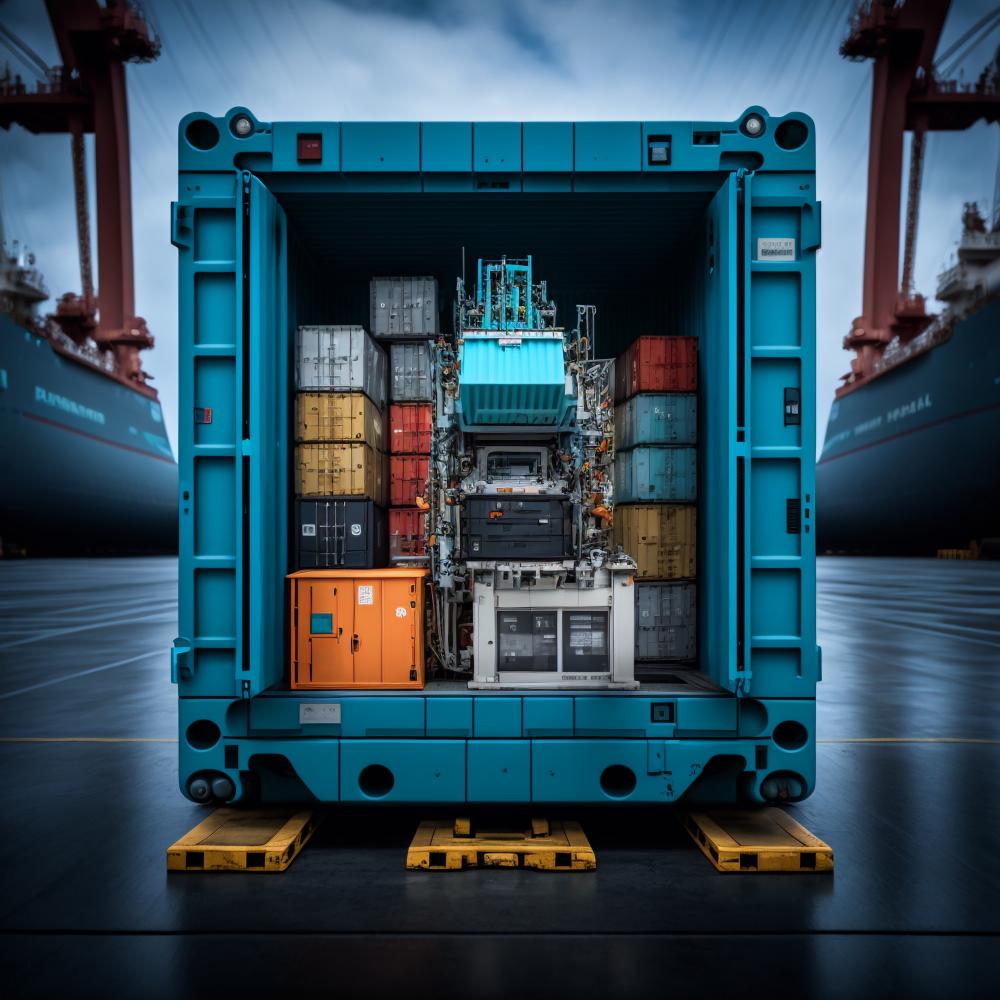ISO Shipping Containers

Origins of ISO Shipping Containers
ISO Shipping Containers have revolutionized international trade and logistics, thanks to their standardized design and durability. Originally developed to enhance military logistics during the mid-20th century, the evolution of these containers transformed global shipping methods. Their robust construction and standardized sizes facilitate seamless integration across multiple modes of transport including ships, trucks, and trains, hence the term “intermodal” containers.
The history of standardized containers began with the United States Army using modular containers called “Conex boxes” in the Korean War. These early models laid the groundwork for what would become the modern ISO Shipping Containers seen today. By adopting international standards, container shipping significantly reduced transportation costs and increased efficiency in global trade.
Defining ISO Standards
The acronym ISO stands for the International Organization for Standardization, which sets globally accepted metrics for various products, including shipping containers. This standardization ensures compatibility and safety across different logistics systems worldwide. By complying with ISO standards, containers guarantee uniformity in size, capacity, and strength, ensuring they can be reliably used in international shipping.
ISO certification involves rigorous testing processes that containers must undergo to meet predefined standards. This certification allows businesses to transport goods with confidence, knowing that their containers adhere to strict safety and performance guidelines. The reliability of ISO Shipping Containers means they are a trusted option for businesses looking to ship goods across borders.
Standard Sizes and Capacity
ISO Shipping Containers are available in a range of standard sizes to accommodate different shipping needs. The most prevalent sizes include 20-foot and 40-foot lengths, both available in standard and high-cube forms. High-cube containers offer an extra foot of height, adding valuable volume for transporting taller cargo.
With a consistent design, these containers maximize space usage on cargo ships and simplify stacking during transport. The standardized dimensions also allow for efficient handling at ports and compatibility with a wide array of transportation vehicles worldwide. This consistent sizing not only simplifies logistics but significantly optimizes the supply chain’s cost-efficiency.
Material and Durability
Constructed primarily from corten steel, ISO Shipping Containers are designed to resist harsh environmental conditions, ensuring long-term durability. Corten steel, known for its weather-resistant properties, helps containers withstand extreme temperatures, moisture, and corrosion, preserving their structural integrity over time.
This robust material choice ensures that the containers can endure long-distance shipments across various climates without compromising the safety of the goods they transport. The dependability of corten steel makes these containers a valuable asset for any business involved in international trade or requiring long-term storage solutions.
Versatile Applications
Beyond their primary role in transportation, ISO Shipping Containers have found diverse applications in modern industries. Many businesses repurpose retired containers as secure, weather-resistant storage units for construction sites, agricultural projects, and retail operations. Their adaptability extends to creative uses like pop-up shops and office spaces.
In the architectural domain, the containers are affectionately deemed “cargotecture.” This trend involves converting containers into innovative living or working spaces. The sustainable and modular nature of containers makes them an attractive option for eco-conscious projects aiming to minimize environmental impact while retaining unique design elements.
Cargotecture: Innovation in Design
Cargotecture is the practice of designing buildings using shipping containers as modular elements. Companies like GEM leverage this trend to create bespoke solutions tailored to client specifications, offering an array of commercial and industrial applications. GEM’s expertise allows them to transform containers into functional, aesthetically pleasing spaces without sacrificing structural stability.
Through cargotecture, containers become a canvas for architects and builders to explore new architectural frontiers. These designs can vary from individual living units to expansive office buildings, characterized by their contemporary appearance and efficient use of space. This innovative approach to construction aligns with modern sustainability goals, providing eco-friendly building options without compromising on design.
Energy Solutions with ISO Containers
One of the standout features of ISO Shipping Containers is their capacity to house integrated energy solutions. GEM specializes in utilizing these containers to develop containerized power systems and microgrids, offering a sustainable alternative for energy needs. These solutions provide resilient power options, particularly useful in remote areas or disaster zones where traditional infrastructure may be lacking.
Containerized battery energy storage systems are another area where ISO containers shine. By integrating battery storage within the container, businesses can store renewable energy efficiently, manage peak demand, and reduce reliance on fossil fuels. This not only optimizes energy consumption but also contributes to reducing the carbon footprint of energy-intensive operations.
Customization and Modifications
ISO Shipping Containers offer substantial customization options, allowing companies like GEM to provide tailored solutions that meet specific client needs. Whether it’s adding custom doors, windows, or climate control systems, containers can be adapted to suit diverse applications. GEM’s team of skilled fabricators and mechanics excels at converting containers into bespoke units with unmatched precision.
Customization extends to incorporating specialized coatings, enhanced security features, or additional structural modifications. These adaptations ensure the containers are not only functional but also meet industry standards for any intended use. This flexibility enhances the container’s value, making it a sound investment for businesses seeking versatile, long-term solutions.
Impact on Various Industries
ISO Shipping Containers play a crucial role in numerous industries beyond logistics and transportation. In the construction sector, they serve as temporary site offices or secure storage for equipment and materials. For disaster relief organizations, containers provide immediate, portable housing solutions for displaced communities.
In retail, containers offer a unique market presence, enabling businesses to set up temporary shops with minimal initial investment. Artists and designers also find value in containers, using them as exhibition spaces for showcasing creativity in mobile formats. Their contribution to sustainability and versatility continues to inspire innovative uses across multiple sectors worldwide.
Future Prospects of ISO Shipping Containers
As global trade continues to evolve, ISO Shipping Containers will undoubtedly remain at the forefront of logistical innovation. New materials and technological advancements promise to enhance their resilience and functionality, further broadening their application scope. The push towards sustainability is likely to drive the development of even more environmentally friendly container solutions.
Looking ahead, advancements in smart technologies might integrate with containers, providing real-time data on cargo conditions and enhancing supply chain transparency. As the world embraces more interconnected systems, ISO Shipping Containers will continue to play a pivotal role in supporting efficient, secure, and sustainable global trade practices.

What does ISO stand for in shipping containers?
ISO stands for the International Organization for Standardization, which is the body responsible for creating global standards across various industries, including shipping. With ISO shipping containers, these standards ensure that containers are consistent in size, capacity, and strength, which allows for seamless integration into different transportation systems worldwide. Imagine trying to stack a Lego tower with differently sized blocks — it wouldn’t work well. Similarly, standardized ISO containers make global shipping more efficient and less costly. Ever wondered how these standards evolved over time and whether they’ve reached their final form? Share your thoughts!
What is the standard ISO for tank containers?
The standard ISO for tank containers is ISO 668, which defines the classification, external dimensions, and ratings for tank containers. These tanks are typically used for transporting bulk liquids and are designed to fit seamlessly into intermodal transport systems, just like their dry container counterparts. Tank containers are a bit like the Swiss Army knife of shipping containers — versatile and robust, built to handle a range of products while maintaining safety and efficiency. With advancements in materials and technology, where do you see the future of tank containers heading?
What does ISO code mean in container?
An ISO code in container shipping is a standardized identification system that describes the type and size of a container. Think of it as the container’s passport; it provides essential information that ensures compatibility across the global shipping network. These codes simplify logistics operations by maintaining consistency and providing clear identification. At GEM, we find this standard particularly useful as it aids us in designing customized solutions that still comply with these global standards, ensuring seamless deployment across various transportation modes. Have you encountered any scenarios where the ISO code made a significant difference in the logistics process?
Is ISO container the same as Conex?
While both ISO containers and Conex boxes have roots in military logistics, they are not exactly the same. Conex boxes were the precursors to modern ISO containers, initially used during the Korean War to streamline military logistics. ISO containers have since evolved with standard dimensions and durability specifications, making them suitable for broader commercial use. Think of the Conex box as the prototype that paved the way for the ISO containers we rely on today. At GEM, we appreciate this evolution as it underscores the importance of innovation in addressing logistical challenges. What are your thoughts on how military advancements have influenced modern logistics?
How are ISO containers used in cargotecture?
ISO containers are the building blocks of cargotecture, a creative architectural trend that uses shipping containers for constructing homes, offices, and commercial spaces. These containers offer a durable, eco-friendly, and cost-effective solution for building unique structures. At GEM, we revel in the possibilities that cargotecture presents, allowing us to work with clients to create personalized and sustainable living or working environments. Picture transforming a shipping container into your dream office space; it’s modular, customizable, and can even be moved if the need arises. Could cargotecture be more than just a trend, becoming a staple in sustainable architecture? Let’s explore together.
What are energy solutions available with ISO containers?
ISO containers offer innovative energy solutions by housing integrated systems like containerized power modules and microgrids. They can be fitted with renewable energy storage systems, such as solar panels combined with battery units. Imagine powering a remote construction site or a pop-up medical facility using a containerized power solution. GEM specializes in these adaptations, enabling reliable and sustainable energy solutions across various environments, particularly where traditional infrastructure might fall short. As energy needs continue to evolve, how could these modular systems further contribute to a sustainable future?
Resources
- International Organization for Standardization (ISO) – The official website of the International Organization for Standardization, the governing body responsible for setting global standards for various products, including shipping containers.
- United States Agency for International Development (USAID) – USAID plays a crucial role in disaster relief efforts and utilizes ISO Shipping Containers for providing immediate, portable housing solutions for displaced communities.
- United Nations (UN) – The United Nations is actively involved in sustainable development goals, and ISO Shipping Containers play a role in achieving these goals through innovative uses in various sectors.
- Centers for Disease Control and Prevention (CDC) – The CDC utilizes ISO Shipping Containers for the safe storage and transportation of medical supplies and equipment during public health emergencies.
- ArchDaily – ArchDaily showcases innovative architectural designs using ISO Shipping Containers, known as cargotecture, providing insights into the creative applications of container-based structures.
